BY ROB FELD
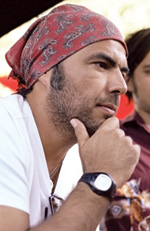 IMPRESSED: Alejandro González
IMPRESSED: Alejandro González
Iñárritu marvels
at Kurosawa's
storytelling skills in Ikiru.
Akira Kurosawa first conceived of
Ikiru with a simple note on a page: "A story about a man who only has 75 days left to live." Alejandro González Iñárritu was a 19 year old in Mexico when he first encountered the film during a Kurosawa retrospective at the Cineteca Nacional. Twenty-five years later, while preparing for his new film,
Biutiful, he revisited
Ikiru and found that what had seemed like a simple, intimate work revealed itself as a highly complex piece of filmmaking, speaking to grand human themes through the microcosm of its narrative.
"The story seems predictable in the beginning but Kurosawa makes an ingenious move, subtly surpassing the predictability and instead makes the events inevitable, which is very difficult," says Iñárritu, as we prepare to screen the film in his Venice office. Biutiful, like Ikiru, is the story of a man with a terminal illness, racing to find meaning in his life. "I think Kurosawa was one of the first storytelling geniuses who began to change the narrative structure of films. The expected vertical line of Ikiru's narrative breaks when Kurosawa does a flash-forward in the middle of the film. That's what I remember."
Iñárritu watches as an X-ray of stomach cancer fills the screen in the very first frame of the picture. The dying man of Ikiru is a government bureaucrat, Kanji Watanabe (Takashi Shimura), a public affairs section chief. We are told he is unaware of his illness and that he has, in essence, wasted his life by allowing himself to be consumed and rendered passionless by the bureaucracy for which he has worked for 30 years. Ninety minutes into the film Kurosawa will jump forward in time, to after Watanabe's death, with many unanswered questions and fifty minutes of screen time still remaining.
In the second scene, however, Kurosawa wastes no time characterizing Watanabe, hunched in his office stamping forms, stacks of dust-covered paper all around. "I love this funny montage," says Iñárritu, as a group of local mothers enters to complain about a toxic sewage pond, requesting that it be filled and made into a playground. Without looking up, Watanabe refers them to Engineering, sending them through 15 other offices in the bureaucracy in rapid succession, before they come back to him empty-handed.
"For the time I think it was an unusually rapid narrative cutting," Iñárritu notes, "and it's the only time Kurosawa uses it as part of the film's language. He never repeats this again. It's not a device; it won't be symmetrical. It's just used here to tell how bureaucrats are bureaucrats."
Iñárritu will marvel repeatedly at Kurosawa's ability to draw on the various tools of storytelling at whim, without letting them take over or box him in to a style in which he doesn't wish to work. Even the very tone of the film, he notes, seems to bend to Kurosawa's will.
"What I like, too," he continues, "is that Kurosawa has put this personal, existential tragedy in the context of political criticism," something Iñárritu himself has accomplished with films like Amores Perros, 21 Grams, and Babel. "He's going from the individual, interior experience to a greater problem encompassing the spectrum of society. It manages to show you big things with a sense of humor as well. Look at these bureaucrats with the paper stacked between them—it's like a storyboard from a graphic novel. But little by little as the film starts to develop it gets a more realistic tone. I'm sure this wasn't planned, but Kurosawa, feeling the weight of his subject during shooting, moved the tone away from humor toward almost social realism."
As Watanabe awaits the results of his X-ray at the hospital, he realizes his fatal diagnosis as another man, also waiting, rattles off the symptoms of Watanabe's cancer. Iñárritu keys in to the deftness with which Kurosawa blocks dialogue scenes like this one, which could otherwise be static.
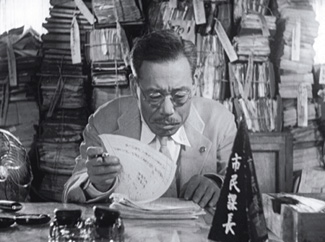 Kurosawa finds the humor in a scene of his bureaucrat
Kurosawa finds the humor in a scene of his bureaucrat
hero dwarfed by piles of accumulated papers.
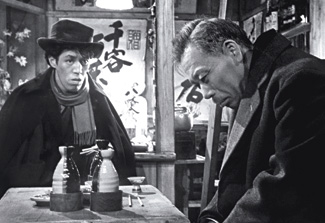
CONFESSION: Iñárritu found the scene in which the dying
Watanabe (right) confesses his illness to a stranger he meets
in a bar so moving that he "borrowed" it for his own film.
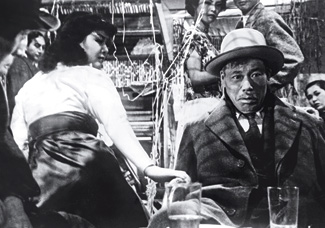
BREAKING OUT: The design and lighting help set up a
scene in which Watanabe's new friend takes him out on
the town for the first night of debauchery in his life.
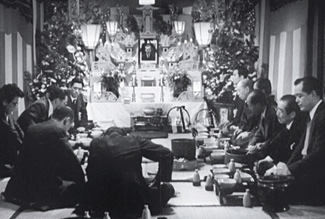
HOMAGE: : Kurosawa manages to show Watanabe's drunken
co-workers at his funeral like "rats gossiping in a box," but
without losing the scene's subtlety of tone.
"This guy is like the Angel of Death, or the fearful conscience he cannot escape. In one take they move around in a circle; the 'angel' starts from where Watanabe is sitting, moving to the right, pushing Watanabe toward the camera, trapping him, and we see the desperation in his eyes. A woman enters and sits to his left, also in pain. It's an interesting triangle. It's the nature of Kurosawa to keep things moving, even when the action is just in one room. He keeps a dramatic objective, questioning, flowing. Even in this scene of maybe three minutes of dialogue, the way he blocks things is unique and smart."
Leaving the hospital, Watanabe slouches home through the streets in a daze. Kurosawa again makes a one-time stylistic turn by employing a total lack of sound. "This is an amazing moment," Iñárritu says, leaning forward, almost drawn in to the picture. "We are in a completely silent moment of reflection, you are in his mind, and I think from here the tone of the film starts to change to something more sober. To submerge the sound completely and then Vroom!" Watanabe is startled out of his thoughts by a truck that nearly hits him, and loud street ruckus returns. "Life again, saying wake up, you have to do something! Today, using sound like that would be very obvious, but I think at the time it showed a masterful understanding of how to play with audio to submerge us in Watanabe's feelings and point of view."
Watanabe's son and daughter-in-law return to his darkened home, selfishly complaining about the house Watanabe has provided and making plans for his money. "I love the eloquence and subordination of the lighting, all these dramatic contrasts within this little space. The introduction of these characters, who are really cruel, in the darkness, and then, suddenly look at that frame!"
They flick the lights on and find Watanabe hunched on the floor, shot from above, in shock from his diagnosis. "Like a little rat being discovered, he's caught," says Iñárritu. "And look at them in the shadows, mysterious. I love the shadowy way he's presenting these characters, going through this labyrinthine home like rats. It's beautiful and effective, influenced for sure by [cinematographer] Gregg Toland. Also, note the physical language of Shimura's performance. In the beginning it feels really pushed, but once you get into his universe it works. You feel the weight of his body, you feel it on your back."
In a montage of memories, the shot pans down with Watanabe as he lowers into a seat at his son's baseball game, then matches his face on a cut into the next scene as the camera cranes up above Watanabe, and cuts again into the movement of an elevator lowering his son on a gurney before appendix surgery.
"That camera move was interesting," Iñárritu says, "crossing lines and memories. Look at the mechanics of the editing, the design going from the flashbacks. It's subtle, but shows how his brain is moving deeper into his floating memories. Kurosawa is using these classical tools of melodrama effectively, which is why the leap forward later is so surprising; you never expect such an academic film as this to suddenly do something so contemporary. That's what I love."
Wallowing in a bar by himself, Watanabe confides in a bohemian novelist in a scene that so impressed Iñárritu, he "borrowed" it for Biutiful. "I can say homage or all those words that they invent, but I stole it. I applied it differently but I stole it," he laughs. "The confession by a guy who is dying to an unknown person is such a powerful thing."
The novelist takes Watanabe out for the first night of drunken debauchery of his life. Gambling, women, neon, dancing and music. Iñárritu brims with excitement at Kurosawa's handling of the sequence and its design.
"I think visually the design of this whole section is fantastic," Iñárritu says. "The lighting is unbelievable," he notes as the two men drink in a tavern. "It plays with a lot of contradictions—from a lonely, dying man confessing to a stranger, to a wild night of Eros. Look at that!" Watanabe jumps as slide trombones leap into frame, reminiscent of a Looney Tunes cartoon. "Whack. The graphic thing starts again with the trumpets; like the papers stacked in his office, they say it all."
After Watanabe vomits in an alley, they are now in the back of a taxi between two singing women of questionable repute. In the background the novelist holds his aching head as lights fly over Watanabe's face in the foreground. "Look at that face." Iñárritu shakes his head in appreciation. "The novelist is saying, 'What did I do? I led Watanabe to lose his soul.' But I love the little smile on Watanabe, which says, deeply, 'Thank you, cabrón.' For me, that is genius. It's where Kurosawa is not lost in formal shit. Sure, it's all there but he never loses the intimate, micro detail of a real human moment. He's always concentrating on what the scene is about; and it's about thankfulness, but with subtlety. It's moments like the smile that make it for me."
The last we see of Watanabe alive is when he rushes from his office, intent on fixing that sewage pond for the local women while he can. The film then cuts to five months later and Watanabe's funeral portrait.
"I think this is the moment where the film flips," says Iñárritu, settling back in his chair in as the story deepens. "Everything up until now you think, oh, fine, he changed his life, but look at that!" he says, pointing out a shot through a window looking into the funeral reception that reveals the faces of petty bureaucrats. "It traps them like rats gossiping in a box: eating, serving themselves, going by the protocol, mechanical, all exactly the same without any personality. To frame them like that minimizes their power. They're dressed exactly the same; all these design elements enhance the idea of bureaucrats as a mediocre mass without individualism or personal ideas."
When the local women enter the room to pay their tearful respects to the man who built a playground for their children, Iñárritu notes the difference in the way Kurosawa handles them.
"Look at the casting of these women; there's no makeup, no absurdity. And look at the bureaucrats, all the shiny hair while the shots of the women look like a documentary or a neorealist film. The lenses don't push or manipulate, there are no wide lenses like he uses with the bureaucrats to make them cartoonish. With the women he uses a normal distance, a 40 or 50 mm lens."
As the bureaucrats' remembrances piece together the missing five months, Iñárritu's comments return to the freedom with which Kurosawa draws from his toolbox.
"The pacing of these flashbacks, integrated into the narrative, are more asymmetrical and random than before, sometimes it's just a single face. In the first half the flashbacks felt more traditional and predictable, melodramatic. But now Kurosawa uses them to keep you moving and reconstruct what happened, but without the classic timing of the flashback. It's less boring the way he's using them. The photography has also become less expressionistic and westernized, and more Japanese: the funeral room is flatter, and there's less reach in terms of light and depth. I felt like those things had been vanishing little by little. It's the strange shift of many elements that makes this film a unique experience."
Iñárritu reacts with awe at the way Kurosawa manages the room full of sitting, drinking family members and bureaucrats, while never losing orientation or allowing a patchiness of action to result from the technical difficulty of shooting.
"Look at all these shots," he notes. "To put so many actors in a state of drunkenness and not lose the subtlety of tone; to plan a shot plus a track that goes from one place to another; to keep the energy growing requires great detail and meticulous observation. These little luxuries that a director like Kurosawa gives, you can't get elsewhere. Once you're shooting a scene like this it's hard to get out of it, then 20 minutes to lay a track and reset blocking; to make that organic requires a real expertise. It's precisely storyboarded, but to maintain the emotional state of the actors in that moment requires great detail and meticulous observation. Sometimes things are different when you roll an hour later."
Back in the government office, the graphics of the film come full circle. The one bureaucrat who took lasting inspiration from Watanabe's efforts is put back in his place by his lazy colleagues, and he sinks behind a stack of papers, as before.
"He is defeated by his own fear," Iñárritu observes. "He stands up, reflects and is again submerged in his bureaucratic life behind the same paper that Kurosawa plays in the beginning as comic. Cinematically, the comment is moving and elegant. It's not a joke anymore; at the end it's the truth."
As the film reaches its final moments, Iñárritu reflects on what he's seen. "Ikiru is existential but with a lot of tenderness," he concludes, as the bureaucrat looks over the playground Watanabe managed to get built. "It's great that Kurosawa made this intimate film after Rashomon and he was only 42 years old. You can see he was trying to make things work on the grand scale that he was used to, but within a smaller story. I felt very compelled by that in my film."
Iñárritu admits Ikiru was not the obvious Kurosawa film to choose as the one that influenced him. "It has the power of sinking in when you are older and given to understanding its subtleties. When I was 19, I remember being surprised by what happened to Watanabe, but I was more surprised by its form than its substance. Now I am more shocked by its substance and the subtleties of the film grammar Kurosawa used. The film is like a sushi roll: it looks small and simple but it's so intricately engineered. When you taste it, wow!"